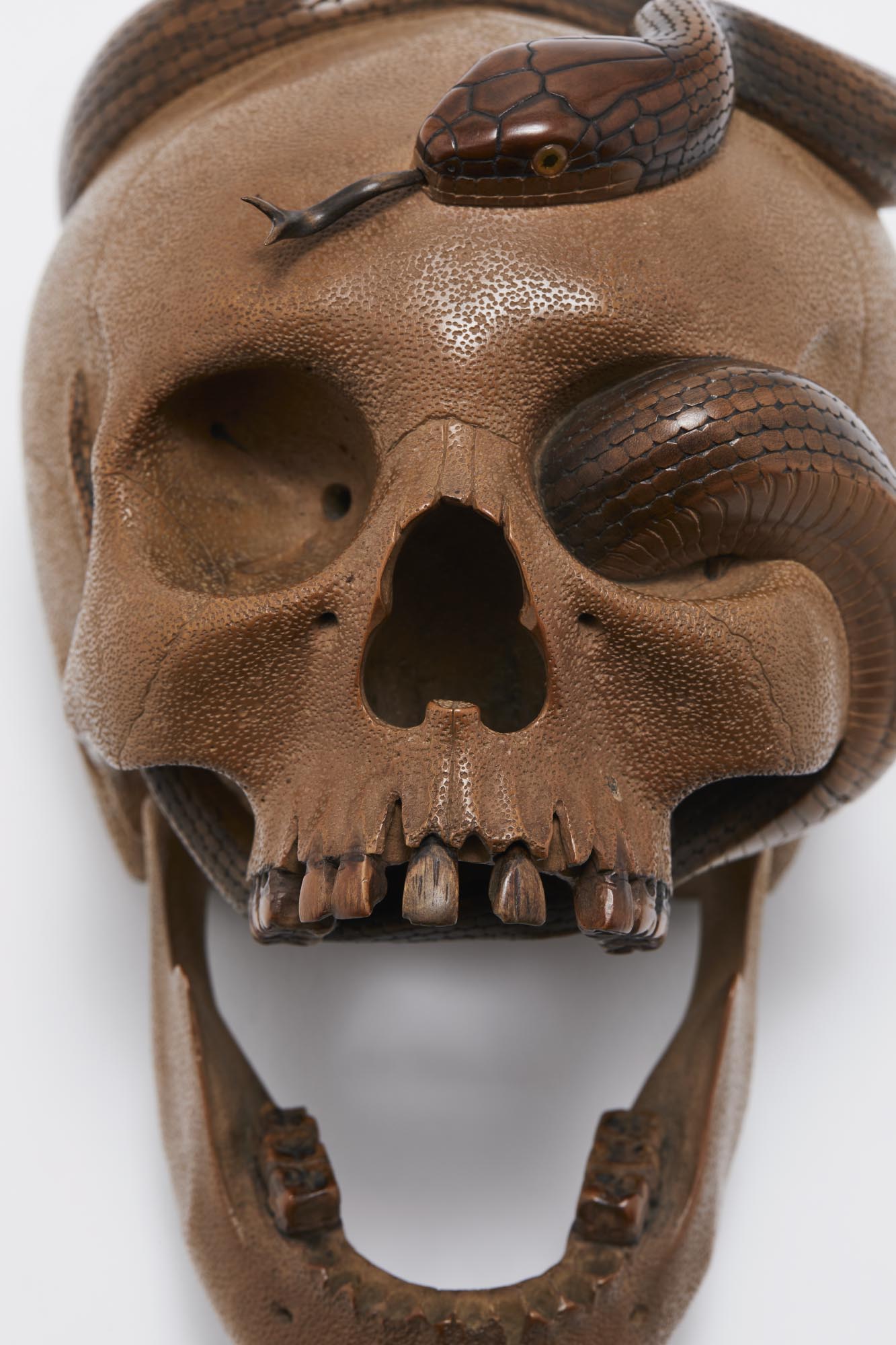Skull
Izumi Sukeyuki / Sculpture
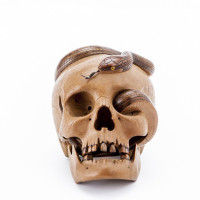
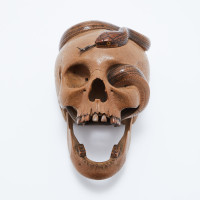
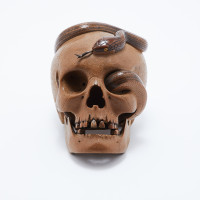
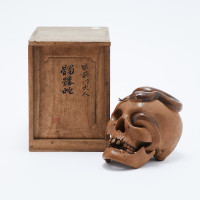
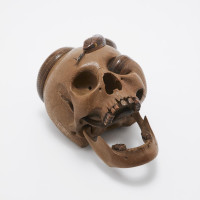
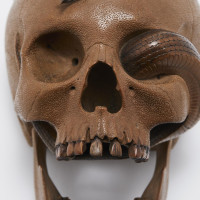
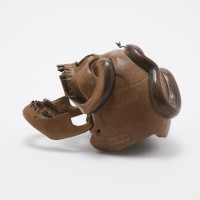
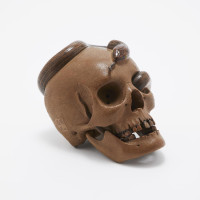
- Contact Us
-
Material
Wood, black buffalo horn and silver
-
Size
10 (h) x 10 x 15 cm
-
Period
1914
-
Box
Wooden box signed
Description
A Japanese "Vanitas"
Okimono by Izumi Sukeyuki
This is an okimono of sculpted wood which depicts a snake winding its way through a skull with an articulated lower jaw and added teeth. Its eyes are inlaid with pieces of blond colored horn set onto gold flakes, and their pupils are rendered with two small pieces of black buffalo horn. The tongue is silver. The head is a natural blond color. Both the reptile and its teeth are in shades of ochre and brown.
Dimensions:
Height: 10 cm
Width: 10 cm
Depth (with the jaw open): 15 cm
The artist's signature 亮之翁刻 Sukeyuki-ō koku (sculpted by the old Sukeyuki) appears in a cartouche at the right side of the base of the skull, and there is a dedication in a square cartouche at the base of the skull's left side that reads: 為前川大人 Maekawa ushi no tame (For M. Maekawa). The absence of a given name would make any attempt at identification futile. The term 大人 (literally "great man"), which is read ushi, was once an honorific title used to designate a person of some importance. At the time this okimono was produced, the Maekawa were a wealthy family of Nara.
Tomobako (wooden box) which has since its manufacture had the inscription Maekawa ushi no tame (For M. Maekawa) on its cover; 髑髏蛇 Dokuro-hebi (snake on a skull); seal: 蟾亭/亮之 (Sentei/Sukeyuki). On the back: 大正三年十月 Taishō sannen jūgatsu (October 1914). 蟾亭亮之七十七翁刻 Sentei Sukeyuki nanajūnana ō koku (sculpted by the old Sentei Sukeyuki at the age of 77); seal: 泉 ( ?) / 亮之 Izumi Sukeyuki.
The Artwork
At first glance, one is struck by the realism of the skull's bones and its dentition, and one is inclined to think that its great precision could easily rival that of the wooden Japanese anatomical models used for pedagogical purposes, first by Hoshino Ryôetsu, a physician in Hiroshima (1792), and then by Kagami Bunken and Okada Banri, physicians in Osaka at the beginning of the 19th century. Upon closer examination with a trained medical eye however, one quickly realizes that this is not the work of an anatomist but of an artist whose intent was not to copy reality slavishly but to create that illusion by playing with the borders between dream and reality. There are certainly some anatomical errors like the left zygomatic arch not being detached from the cranial wall, the vacuity of the nasal cavity, which lacks the vomer and the nasal conchae, and the erroneous placement of the skull sutures. Albeit at the expense of the anatomical inaccuracy of verticalizing the mandibular fossa in such a way as to make it possible to set the mandibular condyles facing inwards, one cannot but admire the sculptural tour de force Sukeyuki achieved by creating an articulated but unremovable lower jaw while avoiding the use of the usual metal pieces with springs. It is likely that the mandible was not a separate piece that was attached to the skull, but rather that it and the skull itself were sculpted from the same single block of wood.
The most astonishing is however still to come. When one turns the object, one is surprised to observe that the skull is sectioned in an unusual vertical frontal posterior cutaway that passes behind the mastoid processes and gives it the appearance of the back of a mask. This illusion is further reinforced by the fact that the endocranium displays no other anatomical bone structure, vascular prints, cranial sutures, sella turcica, etc. (If Sukeyuki had wanted to do so, it would have been easy for him to render these attributes). It is in some sense the reverse of the other side's decor - all of the bone surfaces of the now mute endocranium are entirely carpeted with the abundant gouge marks that cause it to be reminiscent of the back of a Nō mask! Furthermore, Sukeyuki made regular dot marks with an awl on the bone sections that give them a texture more like that of end grain wood, which the material used is not, than that of the spongiform structure of a flat bone. The snake is realistic from head to tail to the point of appearing life-like and it would be incorrect to speak of an uncompleted work here. In the end, the sculptor did not produce a snake taking possession - or coming out of - a skull, but a snake taking possession - or coming out of - a wooden sculpture of a skull. Will we ever know what meaning the artist wished to convey through the kind of mise-en-abîme that this vanitas object displays? By blurring the borders between the work and its model, between the real and the artifice, does the artist intend to remind us that our passage on earth is just a theatrical game that is nothing but illusion?
The Artist
Izumi Sukeyuki泉亮之, whose real name was Izumi Toyojirō 泉豊次郎, was born on the 11th day of the 9th month of Tenpo (February 2nd 1838) in the village of Banba, Sakata Canton in Ōmi (now in the city of Maibara in Shiga Prefecture). He was the eldest son of a family of merchants and farmers. Beginning in his earliest childhood, he amazed those around him with his artistic talents. At the age of twenty-five, while visiting Takayama in Hida Province, he became captivated by the works of sculptor Matsuda Sukenaga 松田亮長 (1800-1871), famous for his netsuke and okimono of reptiles and amphibians, and decided to turn to sculpture using Sukenaga's work as a model. As an homage to him, he took the artist's name of Sukeyuki, which has its first syllable in common with that of his master. He quickly acquired a reputation that allowed him to abandon the family businesses and to devote himself entirely to his artistic activities. In keeping with the spirit of the Hida school, he established that reputation on his sculptures of toads and snakes (whence his artist's name Sentei 蟾亭 - "the toads' flag"), and of skulls. The sculptures of snakes slithering through skulls, which represented a synthesis of two of the subjects he had mastered, became his hobby horse. It is said that Sukeyuki had gone to find his models in old burial mounds and had taken anatomy courses from a physician friend in order to gain a better understanding of muscle tendon insertions. It was in 1891 that a well known episode took place that would bolster the reputation of Sukeyeki's skulls but would surround them with a somewhat maleficent aura. On May 10th of that year, in the course of an official visit to Japan, Tsarevich Nicholas (later Tsar Nicholas II) purchased a skull with a snake from Sukeyuki. On the very next day he became the victim of a failed assassination attempt, when one of the police officers in charge of protecting him gave him a blow to the face with his saber. He owed the fact that his life was saved to his cousin Prince George of Greece who parried the second blow with his cane, but not without the attack having produced a 9 centimeter gash on the intended victim's forehead. In spite of the apologies tendered by Emperor Meiji and the resignation of the minister of the interior and of foreign affairs, historians would later speculate on the influence that this incident might have had on the actions that led to the outbreak of the Russo-Japanese War of 1904-1905. The unfortunate incident did not however in any way stain Sukeyuki's renown, and he was awarded a prize for one of his skulls at the Chicago World's Fair (Chicago Columbian Exposition) in 1893. Sukeyuki did not moreover restrict himself to these macabre subjects - the cane of Prime Minister Okuma Shigenobu (1868-1912) for example, with a snake entwined around it, has remained famous. The sculpture of a pair of mejiro passerines (Zosterops japonicus) in their cage commissioned by the Imperial House of Japan for the marriage of Crown Prince Yoshihito in 1900 is also worthy of mention. In 1920, shortly before his death at the age of 82, he created a magnificent statue of the mythical hero Yamato Takeru no Mikoto for the Shinto sanctuary at the summit of Mount Ibuki.
Symbolic Connotations
Confronted with the very palpable resemblance between the skull and snake sculpture by Sukeyuki, heir of the netsuke-shi of the Hida school, and certain wooden, ivory or ceramic vanitases from the Baroque Period in Northern Europe, one might rightly wonder whether a European influence, or at least a shared source, might not have been operative here. The notion does not seem absurd at first glance. The famous anatomical sketch of the skeleton with the spade, known as the grave digger skeleton in De Humani Corporis Fabrica by Vesalius (1543) influenced anatomical iconography until the Romantic period. It was introduced to Japan at the very beginning of the 17th century by Narabayashi Chinzan in his treatise on surgery titled Geka sōden which was adapted from a Dutch edition of The Ten Books of Surgery by Ambroise Paré, and in which it was reproduced. But in a land in which incineration was favored over burial, what meaning was ascribed to this grave digging skeleton, now become a gardener skeleton? In truth, one would be searching in vain for a connection between Europe and Japan where this image of a snake exploring a skull is concerned, and it certainly precedes any of the first contacts that occurred between these extremities of the world. It must be admitted on the other hand that this image did pop up here and there in these grisly medieval times when references to gallows, ossuaries overgrown with grasses, and snakes were ubiquitous and a part of life's daily landscape.
The memento mori theme is universal. In the West, it reminded that human life is precarious and that one always had to be prepared to die to achieve salvation in heaven and eternal life. In Japan, human life is of course equally precarious, but one had to undergo an interminable series of deaths and rebirths in order to reach Nirvana, Buddha's paradise. In Japan, the bleached skull in the heath, nozarashi ou sarekôbe, is a classic image subject in Zen painting. This Japanese Buddhist school comes from Chinese Chan Buddhism, which flourished during the Tang dynasty period, and was strongly influenced by Taoist texts, especially the Zhuangzi (4th - 3rd centuries BC). A famous apologue, well-known in Japan, relates that Zhuangzi found a skull by the side of a path. He picked it up and used it as a pillow the following night. At midnight, the skull came to him in his dream and began to converse with him. It told him of the world beyond:
The skull said: "After death, no more superiors and inferiors, nor seasons, nor work. There is rest, and the endless time of the heavens and earth. This peace surpasses the happiness of kings." - "Bah!" replied Zuangzhi, "If I could get the maker of destiny to give you back your body, bones, flesh, skin, and your father, mother, wife, children, and all your knowledge, would you find that upsetting?". The skull frowned, rolled up its nose and said: "No! I would never renounce my royal peace, and exchange it for human miseries." (Zhuangzi, Chapter 18, D)
At the end of the same chapter, a similar episode illustrated the metaphysical enigma of death to Liezi:
While traveling, Liezi was taking his meal by the side of the path when he suddenly saw an old skull lying among tufts of grass. He tore out the grasses, pointed with his index finger at the skull, and said to it: "Only you and I know that you are neither dead nor alive. Are you really unhappy? And am I really happy?"
Chinese lore explains this sibylline passage, that can only be understood within the framework of the cycle of deaths and rebirths, as follows:
From the point of view of the old skull that personifies the dead man, life is his death and death is his life. Since Liezi represents the living man, from his point of view life is his life and death is his death. The distinction between life and death is thus relative to a point of view. From an absolute point of view, one does not know if a being is alive or dead.
There are innumerable Zen paintings that depict a bleached skull among wild grasses. A takuhon (white stamping on a black background) by Itō Jakuchū (1716-1800) is among them and bears the kōan inscription: "To each soul, its sack of skin (carnal enevelope); to each sack of skin, its soul". There is also the very humorous drawing by Sengai Gibon (1750-1837) that depicts a skull with reeds growing from its orbital and nasal cavities. The text that accompanies the drawing reads: "Do good and evil come out of the eyes, the mouth or the nose?" It plays on the double meaning of yoshi and ashi, which are two names for the reed, and homonyms for good and evil. One sees nothing tragic or frightening in these Zen vanitases - on the contrary they illustrate serene detachment, and take the derisive tone a pun creates.
Another connotation that is connected with Japanese vanitases, forgotten today but certainly operative at the time that Sukeyuki was producing his work, is that of heroism associated with the exaltation of self-sacrifice until death. During the Meiji period, Japan had within two decades established itself as a major world power and equipped itself with a modern army and navy. Its recent victories over China (1895) and then Russia (1905) gave rise to strong feelings of national pride and patriotism in its people. We remember a Meiji tonkotsu (tobacco container) decorated with a skull and a snake in the grass image bearing the inscription of a couplet in classical Chinese: "The souls of the heroes whose numbers have continued to swell for a thousand years, ardently protect the Country of the Gods (Japan)". Of course, nothing proves that Sukeyuki's inspiration was of this ilk, but it may reasonably be believed that at the time, this patriotic dimension could have contributed to making this kind of object popular.
It remains for us to examine the theme of the snake whose ambiguous symbolism only further complicates the multiple and contradictory connotations which are suggested by a work like this.
The snake, which is so distinguishable from all other animal species, has a simultaneously positive and negative symbolic charge everywhere in the world. In the Bible, it represents the devil who tempted Adam and Eve in Eden, and the instigator of the original sin. But it is also the symbol of prudence as Moses' bronze snake, and is sometimes considered the precursor of Christ because of its power to save, as illustrated by the Greek caduceus. In Japan, it is the messenger of Benzai-ten, the goddess of good fortune, in both the Buddhist and Shinto religions. Its characteristic molt makes it the symbol of resurrection in the Christian religion and that of the transmigration of souls in the Buddhist religion. In Japan however, this metaphysical symbolism is clouded by a popular belief, deeply rooted since ancient times and operative until the Meiji period, that the snake had the power to transform itself into a human being, man or woman, at will, and back again likewise. The fantastic stories about such metamorphoses are as abundant in the Buddhist apologues of the Middle Ages as they are in the kaidan, the supernatural tales of the Edo period that the Japanese were so fond of, and that had been inspired by the popular Chinese literature of the Ming and Qing dynasties. In these stories, the snake is most often the incarnation of the jealous woman filled with hate and resentment as the result of having been scorned or rejected in love. The metamorphosis into a snake can take place de vivo or post mortem.
Sometimes, more subtly, the snake is not the metamorphosis of a human being but the incarnation of an obsession that troubles that person. A well-known drawing by Katsushika Hokusai from the Hyaku monogatari series (A Hundred Fantastic Tales) titled Shūnen (The Obsession) depicts a snake coiled around a funerary stele. Many indications, including a tea bowl decorated with a swastika and filled with a Prussian blue colored liquid, suggest that the deceased is Hokusai himself, and tend to prove that he was illustrating his own obsession with painting pursuing him even after death.
One can see the extent of the semiotic material that was available to an artist or writer of occult and supernatural works. This skull object by Sukeyuki, whose sexual identity cannot be determined, gives rise to all sorts of interpretations. Does the snake represent the soul of a deceased woman leaving her head to undertake some dark act of vengeance? Is it the incarnation of a woman's obsession rejoining the object of an unfulfilled passion after death, as in the tale related by the monk Ichien Mujū (1227-1312) in his volume of tales called Shasekishū (Collection of Sand and Stone) about the soul of a young woman that died of love for a novice monk and became a snake that joined him in his tomb when he died insane? The creations of the last masters of Japanese printmaking, from Katsushika Hokusai to Kawanabe Kyōsai, and from Utagawa Kuniyoshi to Tsukioka Yoshitoshi, attest to the fact: in this realm, the imagination of the Japanese has no limits.
As we have seen, this astonishing okimono by Sukeyuki opens up a very wide field for speculation at the same time that it retains within itself the greatest enigma of all - that of death.
Paris, May 2018
By Alain Briot
- Alain Briot is a medical doctor and a member of the Société Asiatique (Collège de France).





